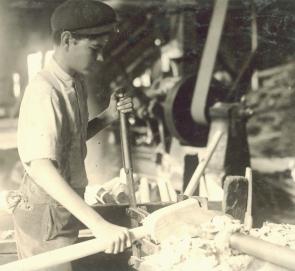History Times: The Industrial Revolution
by Gilder Lehrman Institute
A Changing Nation
 The second half of the nineteenth century can be described as a time of innovation, invention, and rapid growth—a period known as the "Industrial Revolution." Many inventions from this period never caught on or have since become obsolete, but quite a few others—such as the telephone, the automobile, and the airplane—have survived with modifications and improvements, and continue to have an effect on our everyday lives.
The second half of the nineteenth century can be described as a time of innovation, invention, and rapid growth—a period known as the "Industrial Revolution." Many inventions from this period never caught on or have since become obsolete, but quite a few others—such as the telephone, the automobile, and the airplane—have survived with modifications and improvements, and continue to have an effect on our everyday lives.
In the early 1800s, sending messages or information back and forth across the country was a very slow process. It could take as long as one month for a letter to reach its destination. In 1837, Samuel F. B. Morse invented a faster way to communicate. His invention, the telegraph, sent messages from one machine to another along a wire. A telegraph operator sent a message in Morse code—a system of electronic dashes and dots that stood for letters in the alphabet—along a wire. The operator at the other end translated the code into words. Messages that had once taken days or weeks now took seconds.
By mid-century, many people worked for small businesses or on farms, laboring in fields that would yield barely enough food to feed the family. New inventions and technology began to change that, however. Larger factories opened and produced new farm equipment, such as the steel plow and the tractor, which allowed farmers to cultivate bigger fields and produce more food that cost much less.
Prosperity, Poverty, and Progressive Times
After the Civil War, millions of Americans left their small towns and farms to work at jobs in cities, factories, and mines. Manufacturing increased quickly as the demand rose for new mass-produced products such as textiles, telephones, and light bulbs. Factories even made machines for other factories. The factories needed coal to power the machinery, and many new products were made from natural resources such as iron. As a result, new mines were opened across the country. The mines and factories needed workers.
The men who owned and ran these factories and mines grew incredibly wealthy and they became the most powerful individuals in economic, political, and social life in the United States. They built mansions, bought the newest gadgets, threw lavish parties, and traveled the world. Some of them, like Andrew Carnegie and John D. Rockefeller, also used their new wealth to establish institutions like museums, libraries, universities, and hospitals.
The population of urban areas grew quickly. In these overcrowded cities, laborers often suffered on back streets in poor housing, plagued by terrible sanitation, disease, and violence. Workers periodically expressed anger at their bosses for paying them low wages for long working hours by organizing public protests that sometimes led to violence. Millions of laborers eventually organized into unions in an effort to negotiate with their bosses for better wages and working conditions.
Throughout the 1800s, the demand for labor was so great that children were put to work. Employers paid these children less than women, who made less money than men. Textile mills (where fabric and clothing are made) employed children as young as seven years old to work around heavy machinery, sometimes resulting in serious injuries. Young boys worked in coal mines since their smaller bodies moved through tunnels more easily than grown men. Coal dust often settled in their lungs, shortening their lives. These working children toiled up to ten hours a day and didn’t go to school.
By the late 1800s many people believed children should not be working in the factories and mines. The Progressive Movement brought together Americans who believed the government should protect children from the adult world of work. Photographer Lewis Hine used his camera to capture images of children in harsh working conditions and showed these pictures to Congress. The government finally restricted child labor in the early 1900s. Eventually, laws were passed requiring children to be in school instead of at work.
The Birth of "Modern America"
New Innovations in technology and transportation rapidly changed daily life in the United Sates. The telegraph and telephone put people in touch with each other over long distances. Electricity, harnessed by inventors like Thomas Edison and Lewis Latimer, delivered power and light to businesses and homes. Trains crossed the continent and assembly lines rolled out automobiles, allowing projects and people to move quickly from place to place. Orville and Wilbur Wright created the first successful airplane, giving flight to the aviation industry. The great feat of building the Panama Canal in Central America opened a shortcut for ships that otherwise had to sail all the way around South America to get from the east coast to the west coast. These inventions and innovations continue to be improved today. As imaginative as men like Edison, Latimer, and the Wright brothers were, they could not have dreamed of such new inventions as the cell phone and the space shuttle! Yet these modern-day advances wouldn’t exist without the contributions of those early inventors during the Industrial Revolution.
This essay is reprinted from the Gilder Lehrman Institute’s American History: An Introduction, part of the History in a Box series.